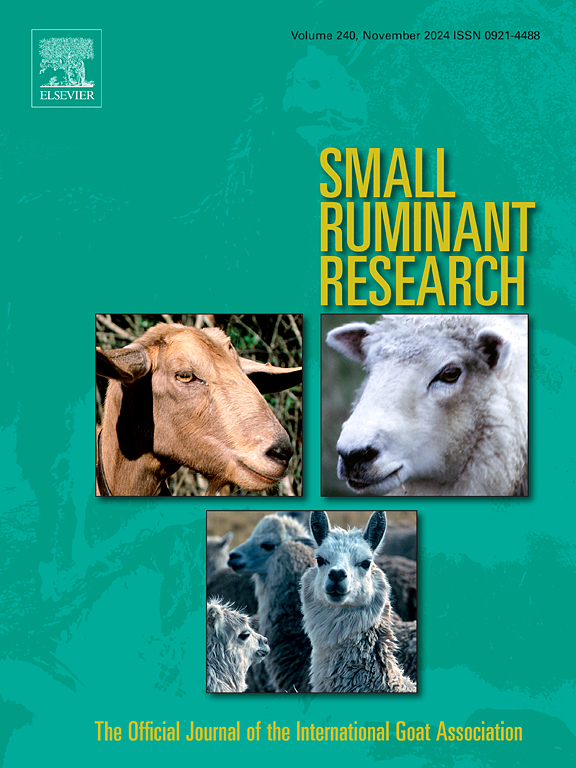高温条件下剪毛对饲养场羔羊生长性能的影响
IF 1.6
3区 农林科学
Q2 AGRICULTURE, DAIRY & ANIMAL SCIENCE
引用次数: 0
摘要
据预测,非洲南部的气温将会上升,因此生产者越来越有可能不得不减轻热应激对生产动物的影响。剪羊毛是提高绵羊耐热性的一种潜在的简单方法,但在南非条件下,还没有对剪羊毛对饲养场生产的影响进行结结性研究。为量化剪毛对多纳美利奴羔羊生产效率和耐热性的影响,试验选取56只公羊随机分为不剪毛组,分别饲喂高能(11.06 MJ/kg代谢能)和低能(9.29 MJ/kg代谢能)育肥期饲粮。在夏季(29˚C± 4)屠宰42天,然后屠宰。每周测量体重、背部脂肪深度和采食量,并在每周最热的一天记录呼吸速率、体表和直肠温度。剪羊毛影响平均增重(312 g/天vs. 347 g/天);P = 0.022)和饲料转化率(5.43 vs. 4.70;P = 0.026),而日采食量(1.62 kg vs 1.59 kg;P = 0.457)未受影响。低能量组采食量较高(P = 0.033),但生长和饲料转化率不受日粮影响。未剪毛的羔羊平均呼吸频率更高(160次/分钟vs 142次/分钟;P <; 0.001),但表面相似(38.35˚C vs. 38.09˚C;P = 0.095),直肠温度与剪短的羔羊相同,这表明通过增加呼吸进行的体温调节足以防止热应激比剪短的动物更频繁地发生。因此,对饲养场动物进行剪毛只对耐热性有很小的改善,并导致生产性能的显著下降,这表明在饲养场条件下,剪毛不能为生产者提供经济效益。本文章由计算机程序翻译,如有差异,请以英文原文为准。
The influence of shearing on growth performance of feedlot lambs under high temperatures
With temperatures being forecast to increase over southern Africa, producers are increasingly likely to have to mitigate the impacts of heat stress on production animals. Shearing offers a potentially simple method of increasing the heat tolerance of sheep, but no conclusive study has yet been performed on the impact of shearing on feedlot production under South African conditions. To quantify the effect of shearing on the production efficiency and heat tolerance of Dohne Merino lambs under feedlot conditions, fifty-six ram lambs were randomly allocated to be shorn or not and provided with either a high (11.06 MJ/kg ME) or low energy (9.29 MJ/kg ME) finishing diet. The lambs were finished off for 42 days during summer (29˚C ± 4) and then slaughtered. Weekly measurements of weight, back fat depth and feed intake were made while respiration rate and surface and rectal temperature were recorded on the hottest day of each week. Shearing affected mean weight gain (312 g/day vs. 347 g/day; P = 0.022) and feed conversion (5.43 vs. 4.70; P = 0.026) over the full growth period while daily feed intake (1.62 kg vs 1.59 kg; P = 0.457) was unaffected. Feed intake was higher in the low energy group (P = 0.033), but growth and feed conversion were unaffected by diet. Unshorn lambs had higher average respiration rates (160 breaths/minute vs. 142 breaths/minute; P < 0.001) but similar surface (38.35˚C vs. 38.09˚C; P = 0.095) and identical rectal temperatures as shorn lambs, indicating that thermoregulation through increased respiration was sufficient to prevent heat stress from occurring more frequently than in shorn animals. Shearing of feedlot animals therefore provided only a small improvement in thermal tolerance and resulted in a significant decline in production performance, indicating that shearing does not provide an economic benefit to producers under feedlot conditions.
求助全文
通过发布文献求助,成功后即可免费获取论文全文。
去求助
来源期刊

Small Ruminant Research
农林科学-奶制品与动物科学
CiteScore
3.10
自引率
11.10%
发文量
210
审稿时长
12.5 weeks
期刊介绍:
Small Ruminant Research publishes original, basic and applied research articles, technical notes, and review articles on research relating to goats, sheep, deer, the New World camelids llama, alpaca, vicuna and guanaco, and the Old World camels.
Topics covered include nutrition, physiology, anatomy, genetics, microbiology, ethology, product technology, socio-economics, management, sustainability and environment, veterinary medicine and husbandry engineering.
 求助内容:
求助内容: 应助结果提醒方式:
应助结果提醒方式:


